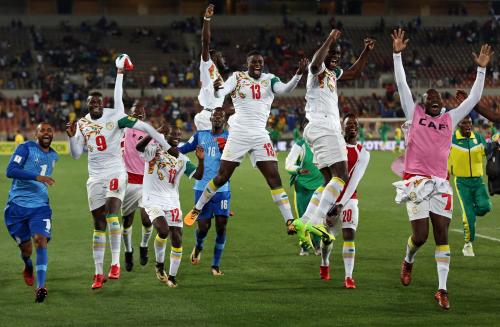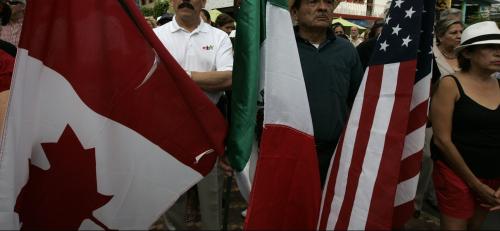Content from the Brookings Institution India Center is now archived. After seven years of an impactful partnership, as of September 11, 2020, Brookings India is now the Centre for Social and Economic Progress, an independent public policy institution based in India.
International soccer, often known around the world as football, is undoubtedly a beneficiary and a symbol of globalization. Over 70 percent of players at this year’s FIFA World Cup play professionally for clubs outside their native countries. Chinese sponsors have shelled out $835 million on the event, contributing more than a third of its advertising revenue despite China not qualifying for the tournament. In many ways, the transnational nature of soccer has helped diminish differences and prejudice: Two decades after the Nigerian-born Polish star Emmanuel Olisadebe was subjected to monkey sounds and bananas thrown at him by his own fans, Nigeria’s Ahmed Musa—who thrived at the club CSKA Moscow—characterizes playing in Russia as “playing at home.” Meanwhile, Egypt’s Mohammed Salah—who celebrates each goal for his club Liverpool by kneeling in prayer—was voted 2018 player of the year in England, just as the British government grapples with thorny questions of immigration and Islamophobia.
However, amid these feel-good stories, there are plenty of signs that nationalism, ethnic tensions, and racial prejudice are alive and well in international soccer. This year’s World Cup has been no exception. While the tournament has fortunately been immune to the worst excesses of tribalism, several incidents reveal the limitations of its globalizing influence.
Divisions, revealed
Questions of nationalism were already manifest in the run-up to this year’s tournament. Last year, Spain defender Gerard Pique was booed by his national team’s fans for his outspoken support of Catalonian independence. During the last European Championship in 2016, Russian and English soccer hooligans fought in the streets of Marseille. In response, Russian President Vladimir Putin initially indulged in taunts (“I don’t know how 200 fans could hurt several thousand Englishmen.”) before the Russian government belatedly distanced itself from the violence, mindful of its responsibilities as 2018 World Cup hosts.
In addition to stoking nationalism, soccer has a long history of bringing out some of the worst in ethnic and religious stereotypes. For example, opposing fans of traditionally Jewish soccer clubs—Tottenham Hotspur in England or Ajax in the Netherlands—have been known to make hissing sounds that are supposed to mimic gas chambers. In Germany, certain soccer hooligan groups reportedly cooperate with neo-Nazi groups, including on weapons training.
To their credit, soccer authorities have acknowledged racism as being a major problem, and have taken some steps to address it. But casual racism nonetheless continues. Last year, the star of France’s team, Antoine Griezmann, posted a picture of himself online dressed as a Harlem Globetrotter for a 1980s themed party, complete with blackface. Following the predicable outrage, Griezmann swiftly deleted the picture and made a perfunctory apology. The controversy was all the more striking given that Griezmann plays for one of the most racially and ethnically diverse national teams in Europe, to the extent that French far-right leader Jean-Marie Le Pen once called it “not a real French team.”
Fans have been as guilty of insensitivity as players themselves. Mexico’s advancement to the second round of this year’s World Cup was a direct result of South Korea’s defeat of Germany. Many Mexicans, wishing to express their gratitude to South Korea, posted pictures of themselves online with their eyes pulled to their sides. Although these fans may not have intended to offend, their racial stereotyping of Asians was apparent.
Beyond questions of race, ethnic and national demonstrations have been on occasional display during this World Cup. In a group stage match, two Swiss players of Kosovar descent made an Albanian nationalist gesture while playing Serbia, recalling the ethno-religious conflicts that scarred the Balkans in the 1990s. That Switzerland has one of the most diverse squads in the tournament—composed of five African-born and three Balkan-born players, as well as seven second-generation immigrants—only contributed further to the incident’s many ironies. And while he quickly distanced himself from his comments, Croatian defender Domagoj Vida—who played for many years with Dynamo Kiev—celebrated his country’s quarterfinal victory over hosts Russia by shouting “Glory to Ukraine,” a slogan associated with anti-Russian protests.
Proceed with caution
If a key question of our times is whether the forces of globalization or nationalism will prevail, international soccer could well be the canary in the proverbial coalmine. There are certainly many reasons to take comfort in the World Cup as a celebration of globalization. But there has also been enough to dent the widespread assumption that globalization would lead inevitability to greater cosmopolitanism, tolerance, and understanding. If international players—part of a rarefied elite that travels the globe, speaks multiple languages, and plies its trade in several countries—can fall back so easily on nationalism or racial stereotypes, perhaps it is time to dismiss with gauzy notions of inevitable universalism.
The Brookings Institution is committed to quality, independence, and impact.
We are supported by a diverse array of funders. In line with our values and policies, each Brookings publication represents the sole views of its author(s).







Commentary
The World Cup exposes the limits of globalization
July 10, 2018